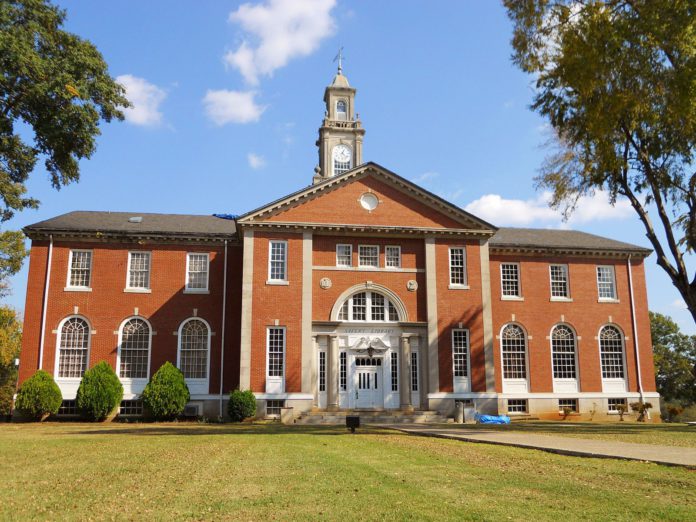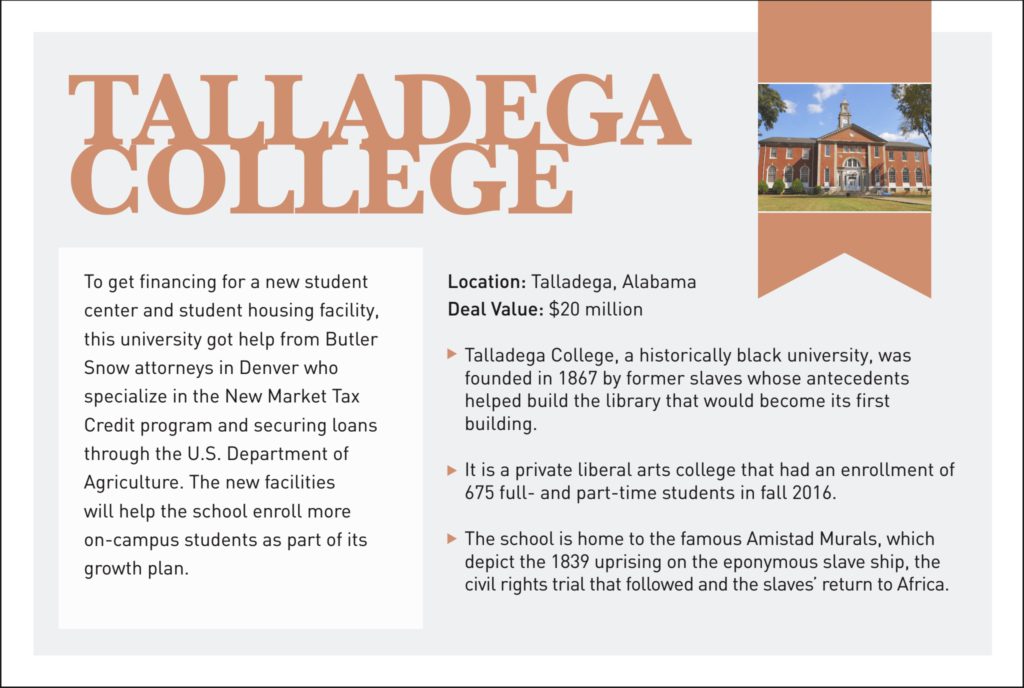
Students at an Alabama college will see new dorms this coming semester thanks to a complicated but effective deal helped along by Denver public finance lawyers.
In April, attorneys at Butler Snow helped close a financing deal that would enable Talladega College to build student facilities in a project worth nearly $20 million. To make it happen, they used a unique funding structure that combined the federal government’s New Markets Tax Credits program with a loan from the U.S. Department of Agriculture.
Founded in the town of Talladega, Alabama, in 1867, Talladega College is one the country’s oldest historically black colleges. It’s a private university that has remained fairly small with its enrollment typically staying under 1,000 students a semester. But like so many other private universities in recent years, the school was experiencing rapid growth in its fixed costs that included faculty salaries and benefits. To try and buoy those costs, the school would look to boost its student enrollment, but that would require additional campus facilities be built, including more housing.
Talladega developed plans for a 47,000 square foot student center and a 103-room student housing facility of roughly the same square footage. The student center would have a new dining hall, gymnasium and convenience store among other amenities.
It would be difficult for the school to finance the campus expansion with a commercial bank, even with its tax-exempt status and donor support, said Thane Hodson, a partner at Butler Snow in Denver who represented Talladega in the financing. He added that Talladega had looked to the USDA for a loan, but the agency wouldn’t finance the whole project cost, so the school had to look at additional options.
What Talladega landed on was a complex tax credit and federal loan structure that made the deal come together. The school would secure a USDA loan for a $20,395,587 portion of the project cost and the rest would come from a private investor — PNC Bank N.A. — using the New Markets Tax Credit program.
The NMTC program encourages private investors to pour capital into projects that benefit economically distressed communities. Talladega College sits in a low-income neighborhood that the USDA declared a food desert, meaning that its residents lack easy access to fresh fruits and vegetables because grocery stores or farmers’ markets in that area are scarce.
 Through an NMTC allocation, a private investor can claim 39 percent of their original investment amount over a period of seven years. According to the U.S. Treasury Department, the NMTC program generates at least $8 of private investment for every $1 the federal government invests.
Through an NMTC allocation, a private investor can claim 39 percent of their original investment amount over a period of seven years. According to the U.S. Treasury Department, the NMTC program generates at least $8 of private investment for every $1 the federal government invests.
While colleagues in Butler Snow’s Birmingham office handled the local laws involved in the Talladega project, Hodson and fellow Denver partner A. Ann Hered worked on the NMTC and USDA issues, which constitute a practice niche for them.
But the USDA’s banking guidelines don’t make it easy to integrate an NMTC structure into the USDA’s banking practices, Hodson said. The Talladega deal required the school’s parent organization, a 501(c)3 nonprofit, to form a tax-exempt affiliate called Talladega College Real Estate S.C. Inc. While the Talladega parent nonprofit got the loan from the USDA, which it used to start building the new dorms, the affiliate’s role was to acquire the NMTC financing.
The focal point of NMTC financing is what’s called a community development entity, which plays the middleman in collecting capital from investors and then distributing it into NMTC-qualified projects. In Talladega’s case, three CDEs allocated an aggregate of $20,000,000 of NMTC money to the project. Combining PNC Bank’s equity capital with the debt capital provided by an affiliate, the CDEs then loaned the total contribution to the Talladega College affiliate. The affiliate is using that money to make lease payments to the Talladega parent nonprofit for the new student facilities.
Meanwhile, the parent nonprofit is building the facilities using the USDA loan. Once the construction is finished, the affiliate will take ownership of the facilities by way of a long-term ground lease, and then lease them back to the Talladega parent nonprofit. It’s essentially a lease-and-leaseback.
“It’s a very complicated financing structure,” Hodson said. “It took a great deal of thought and … time to do the very first one of these.” Since he first started working on them in 2014, Hodson’s firm engineers several NMTC-USDA financings each year following this roadmap in some form. This year they did one for a hospital in rural Kansas, with other recent projects including a medical facility in northwestern Nebraska and a civic center in rural Washington State.
The Talladega financing closed April 19. The school’s new dorms are expected be completed in time for the fall semester with the new student center finishing construction the following spring.
Hodson said part of the reason he enjoys the NMTC financing niche is that the results contribute the community’s wellbeing.
“It’s a very nice practice for us because this time next year, if we were to go visit Talladega, we’d see tangible evidence of the contributions that these kinds of programs make to communities in need. And that’s a very satisfying part of our practice.”
— Doug Chartier

